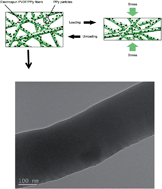Electrically pressure sensitive poly(vinylidene fluoride)/polypyrrole electrospun mats
Abstract
Non-woven mats with highly pressure-sensitive electrical conductivity have been prepared by electrospinning of poly(vinylidene fluoride) (PVDF) containing up to 23 wt% of polypyrrole (PPy) particles synthesized by using dodecylbenzenesulfonic acid (DBSA) as a dopant. The obtained mats have been characterized by dynamic mechanical thermal analysis, differential scanning calorimetry, thermogravimetric analysis, infrared spectroscopy, scanning electron microscopy and nitrogen adsorption BET. Electrical resistivity changes of PVDF/PPy blends were investigated during loading–unloading compressive cycles. It has been observed that the electrical resistivity varies reversibly with the applied compressive stress. The maximum sensitivity was obtained for a PVDF/PPy blend containing 13 wt% of PPy, manifesting an electrical resistivity drop of 10 orders of magnitude, i.e. from 1017 to 107 Ω cm upon application of a compressive stress of 5 MPa. This peculiar response can be attributed to the formation of stress-induced conducting pathways in the electrospun network. Considering the remarkable resistivity change and the reproducibility of the phenomenon after repeated loading–unloading cycles, this mat may find application as a pressure sensor.


 Please wait while we load your content...
Please wait while we load your content...